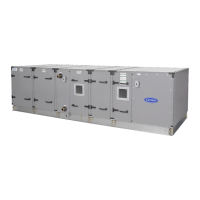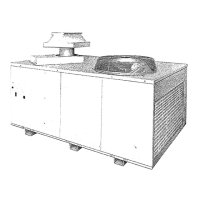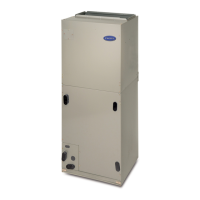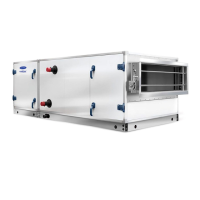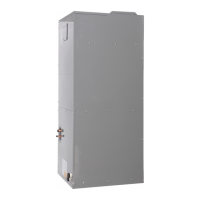260
Table 50 — Humidifier Troubleshooting (cont)
AHU — Air-Handling Unit
Table 51 — Unit Troubleshooting
SYMPTOM POSSIBLE CAUSES POSSIBLE REMEDIES
Condensate in unit
The humidifier is too large. Verify humidifier capacity versus air volume.
There is a high limit controller fault. Verify that high limit controller is working. If necessary, correct problem.
Evaporation distance is too short. Verify and, if necessary, correct evaporation distance to obstructions or
elbows.
Steam valve is leaking. Verify steam valve is not leaking. If necessary, correct leaking steam
valve.
Steam leaks from P-traps
The trap height is incorrect. Ensure that height of trap exceeds the static pressure of the duct/AHU,
especially if under negative pressure.
Valve sizing is incorrect. Check valve sizing to maximum manifold capacity. If necessary, resize
valve within manifold capacity.
There is excessively high steam pressure. Check that inlet steam pressure does not exceed humidifier capability.
SYMPTOM POSSIBLE CAUSES POSSIBLE REMEDIES
Motor fails to start
Power line open Reset circuit breaker.
Improper wiring or loose connections Check wiring and connections.
Overload trip Check and reset overload.
Mechanical failure Inspect motor and drive for operation and/or damage.
Improper current supply Check rating plate against actual supply voltage. Contact
power provider for adjustments if needed.
Motor stalls
Open phase Check line for open phase.
Overloaded motor Reduce motor load or replace with larger motor.
Low line voltage Check supply line, correct voltage.
Excessive vibration
Bearing/shaft misalignment Check and align bearing set screws.
Shipping blocks/spacers not removed Remove shipping blocks/spacers.
Excessive belt tension Adjust belt tension.
Drive misaligned Align drive.
Bearing(s) hot
Grease not evenly
distributed after lubrication Allow unit to cool down and restart.
Over-lubrication Clean and purge excess grease.
No lubricant Check bearings for damage and apply lubricant.
Misaligned bearing Check shaft level and reset alignment.
Motor does not run at
full speed
Low voltage at motor terminals Check supply voltage and correct voltage loss.
Supply wiring to motor too small Rewire with properly sized wire.
Motor overheats
Overloaded motor Reduce motor load or replace with larger motor.
Motor fan is clogged, preventing motor cooling Clean motor fan.
Excessive motor noise
Mounting bolts loose Tighten bolts.
Rigid coupling connectors Replace with flexible connectors.
Worn motor bearings Replace bearings and seals.
Fan rubbing on housing Adjust housing.
Motor runs and then slows Partial supply voltage loss Check for loose/
dirty connections.
Verify supply voltage.
Excessive motor bearing wear
High load due to over-tensioned drive Check belt tension and load.
Excessive overhung load caused by a small
diameter motor sheave
Replace with larger sheave.
Loose Fan Belt
Improper motor position Adjust tension.
Worn sheaves Replace sheaves.
Worn or damaged belt Check sheave alignment and replace belt(s).
Drive Noise
Sheave(s) not tight on fan/motor shaft(s) Tighten sheaves.
Belts contacting guard(s) Adjust or tighten belt guard mounts.
Belts too loose or too tight Adjust belt tension.
Belts and sheaves mismatched Install proper belts.
Belts not length matched (multiple belt set-up) Install matched belts.
Misaligned sheaves Align sheaves.
Belts worn Replace belts.
Belts dirty or oily Replace belts.
No Power to Unit Power switch in wrong position. Verify SPP power switch handle is in the proper position.
Circuit breaker tripped Reset SPP circuit breakers.
Fuse blown Inspect SPP fuses.
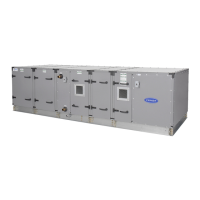
